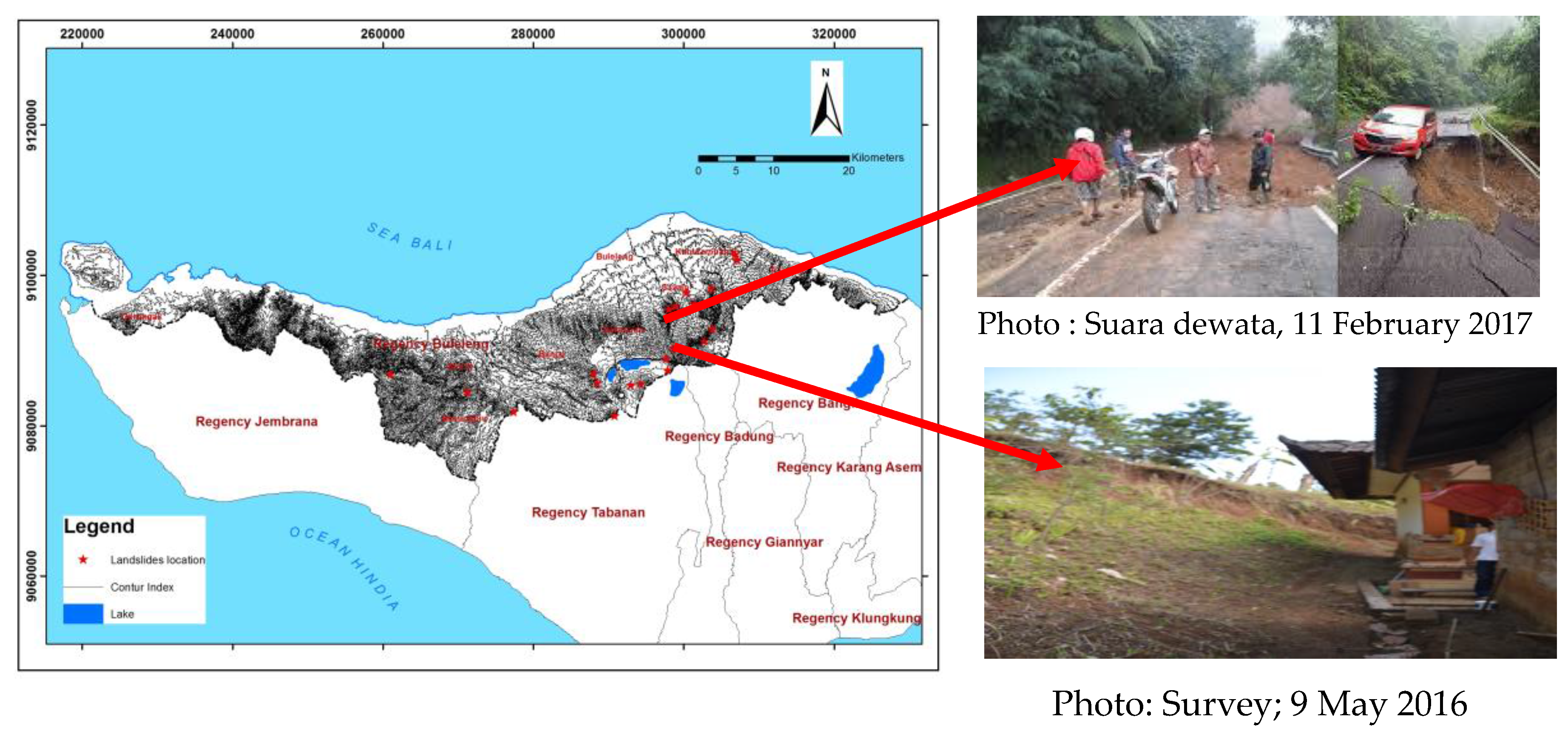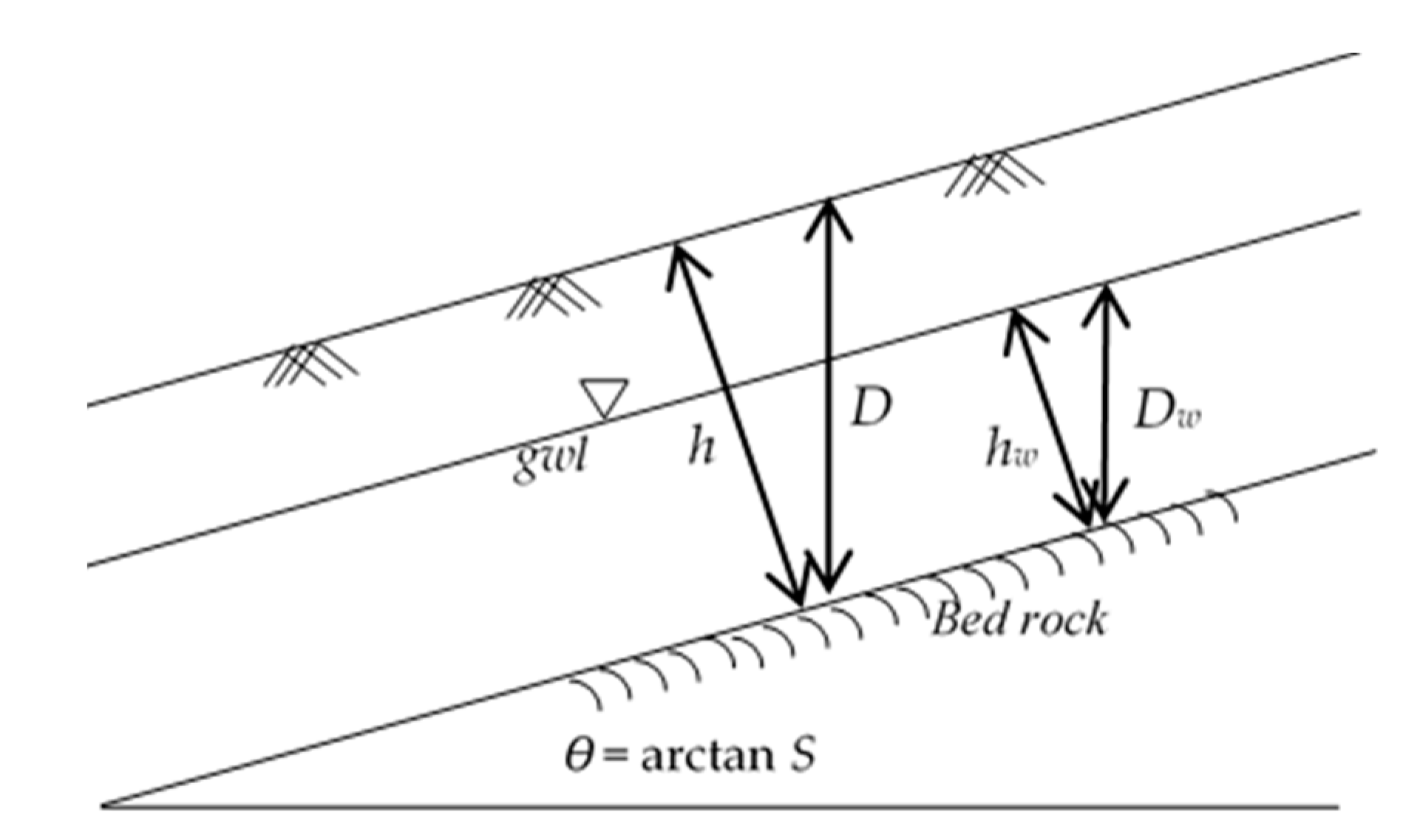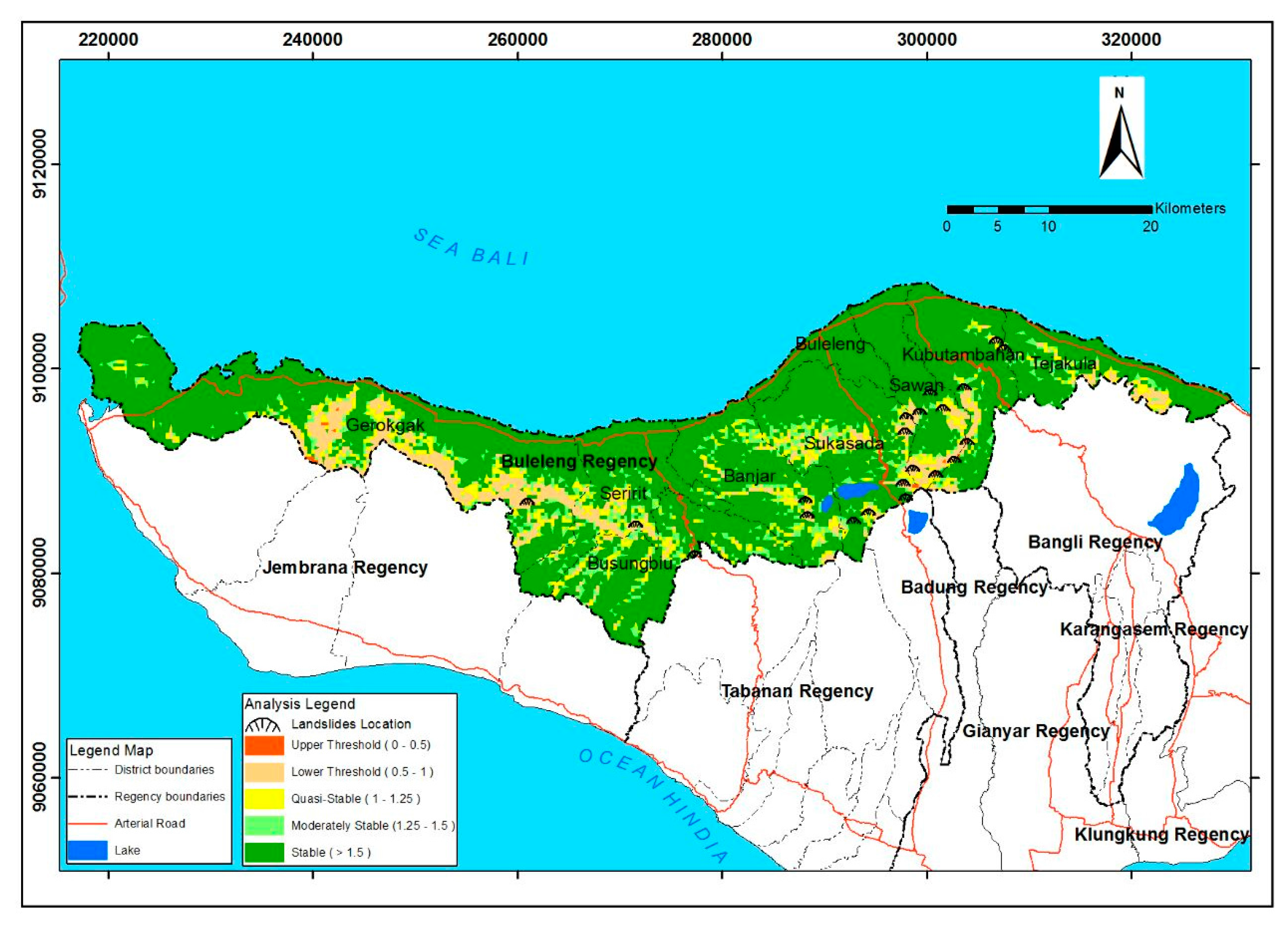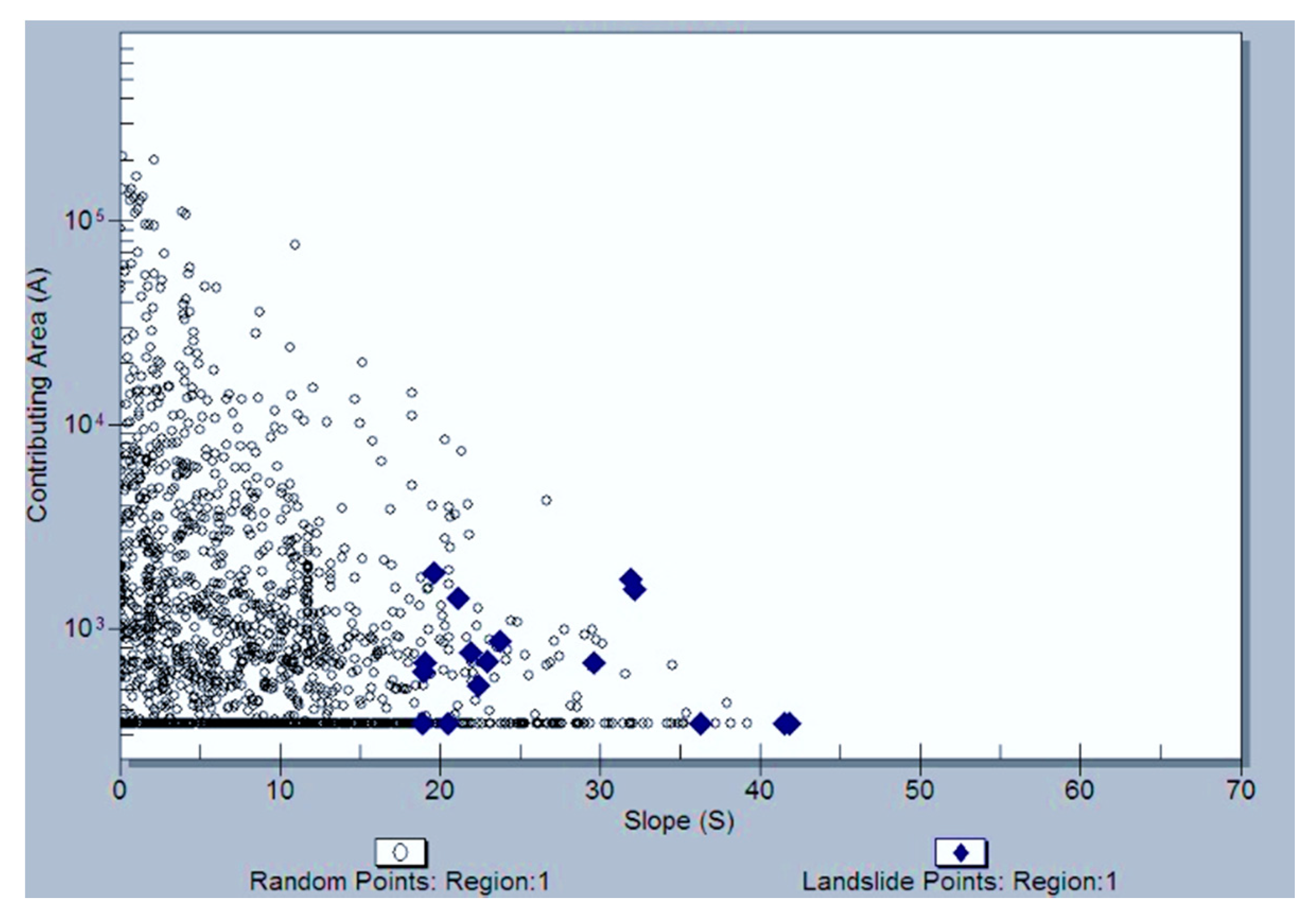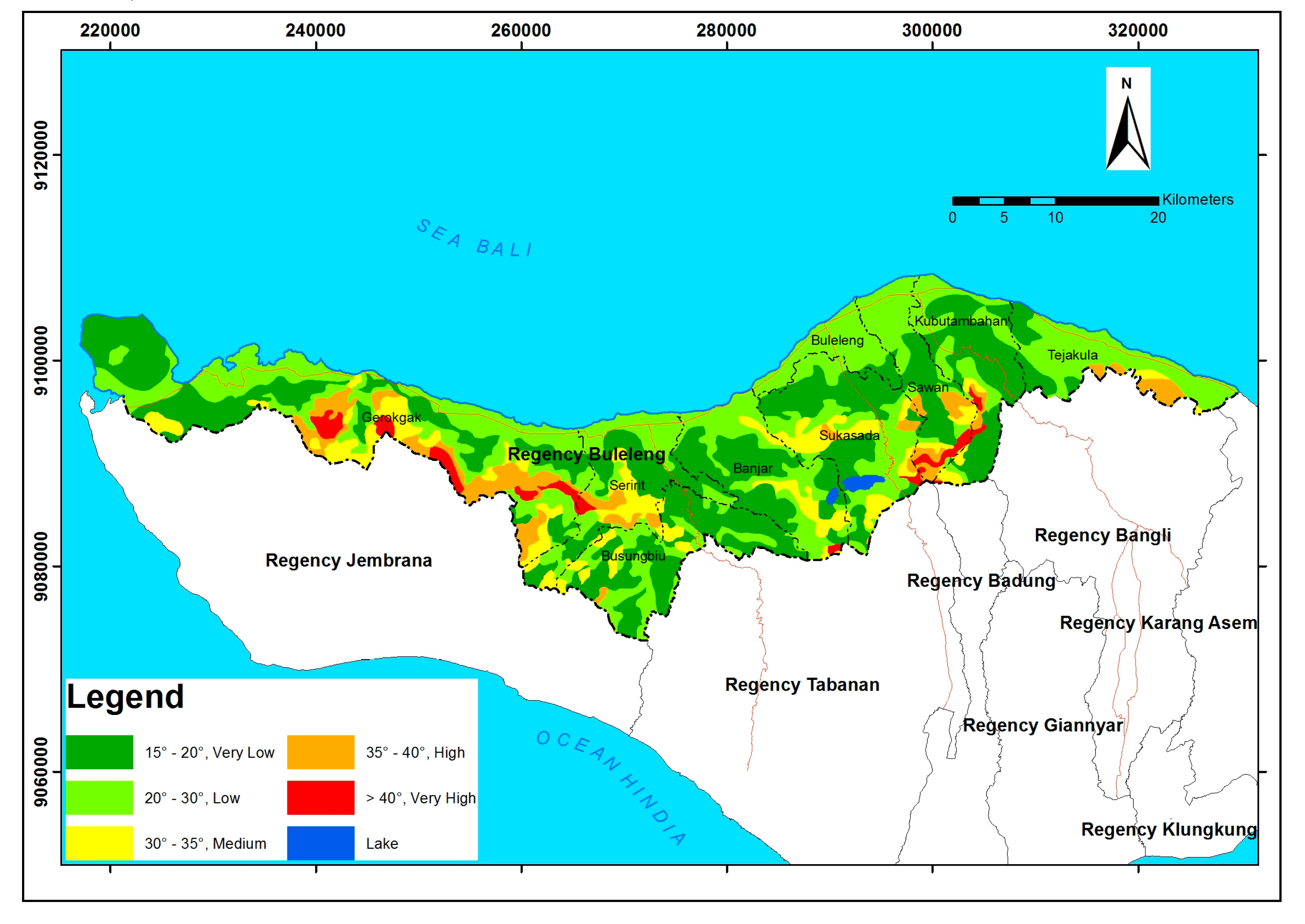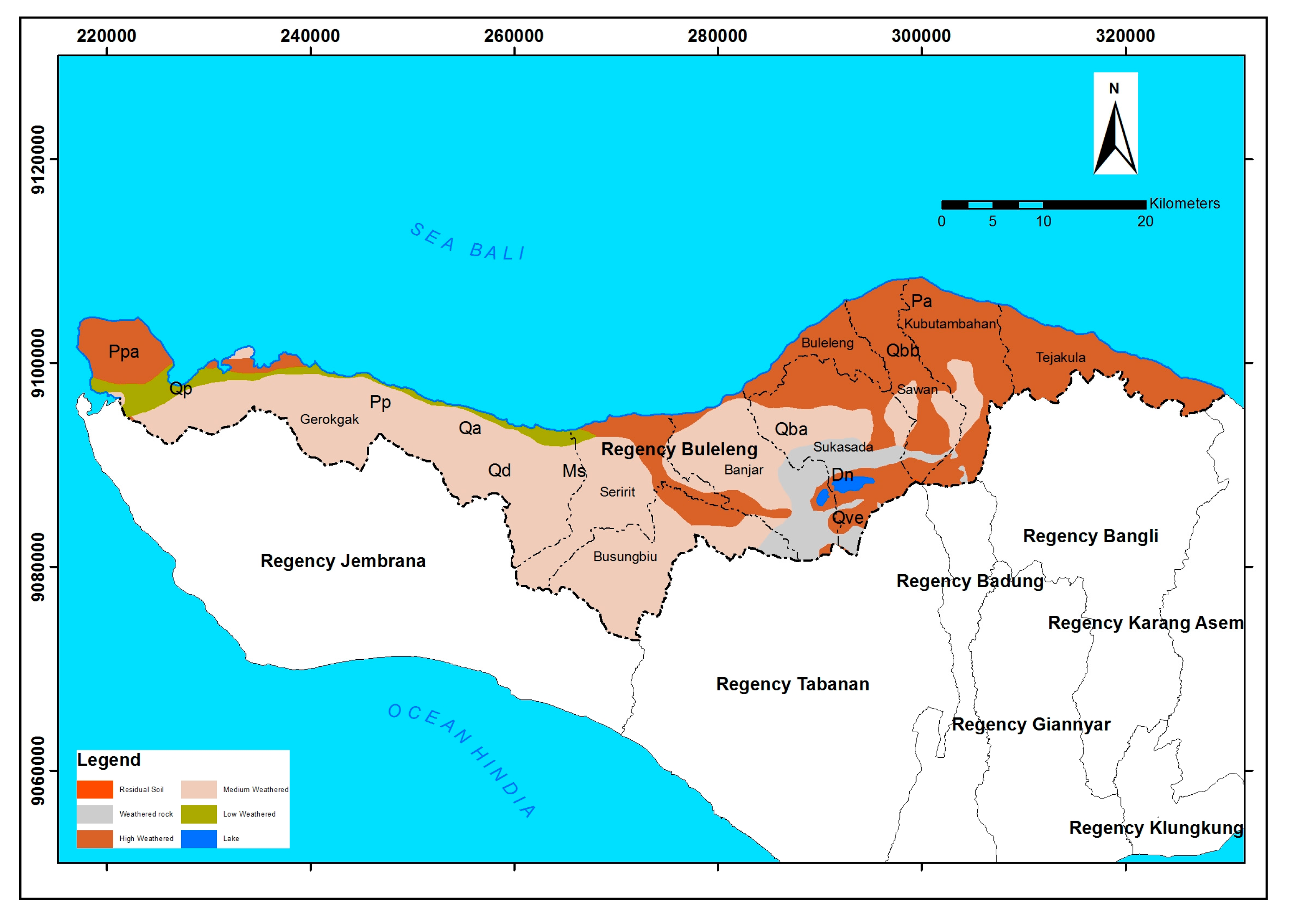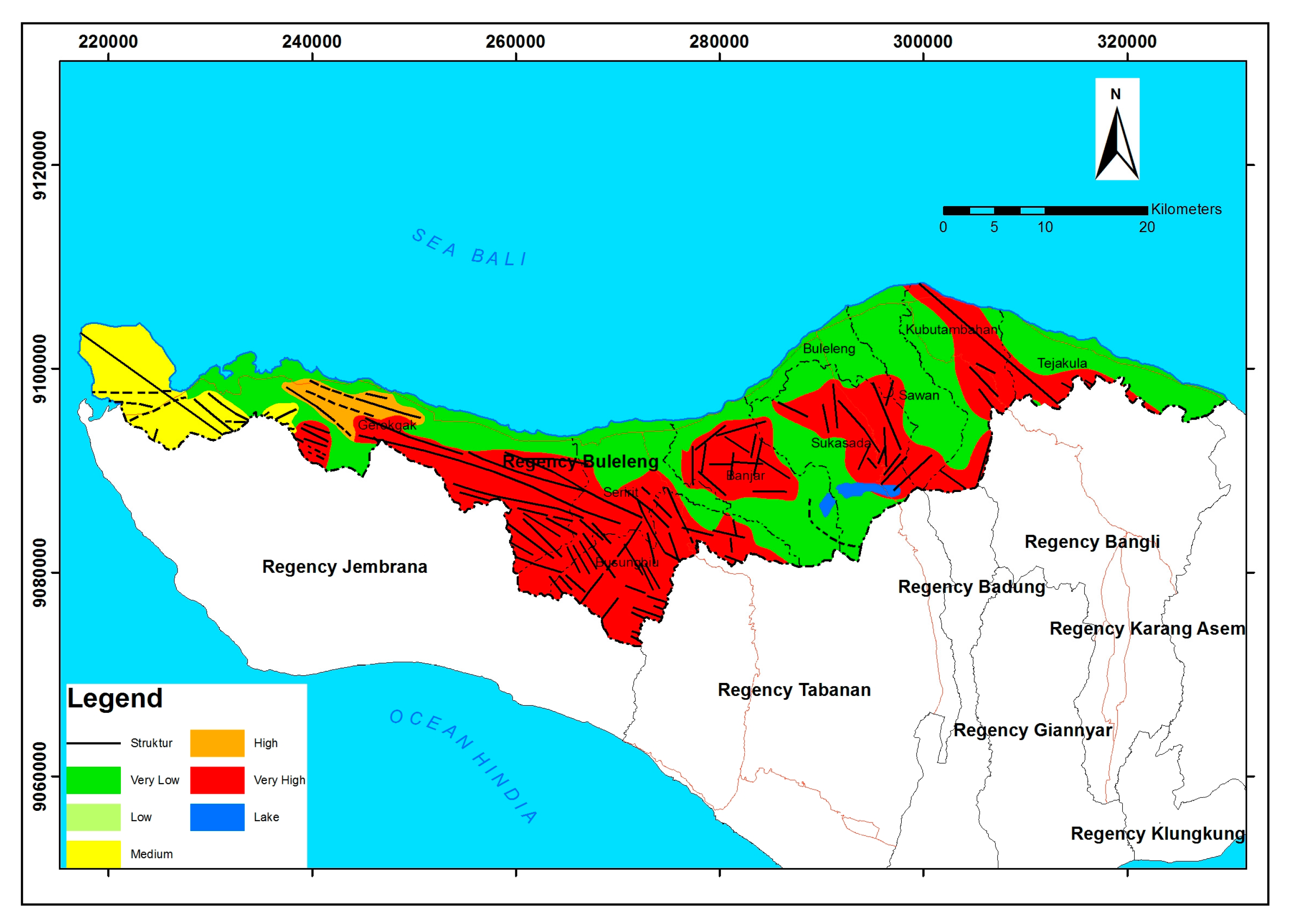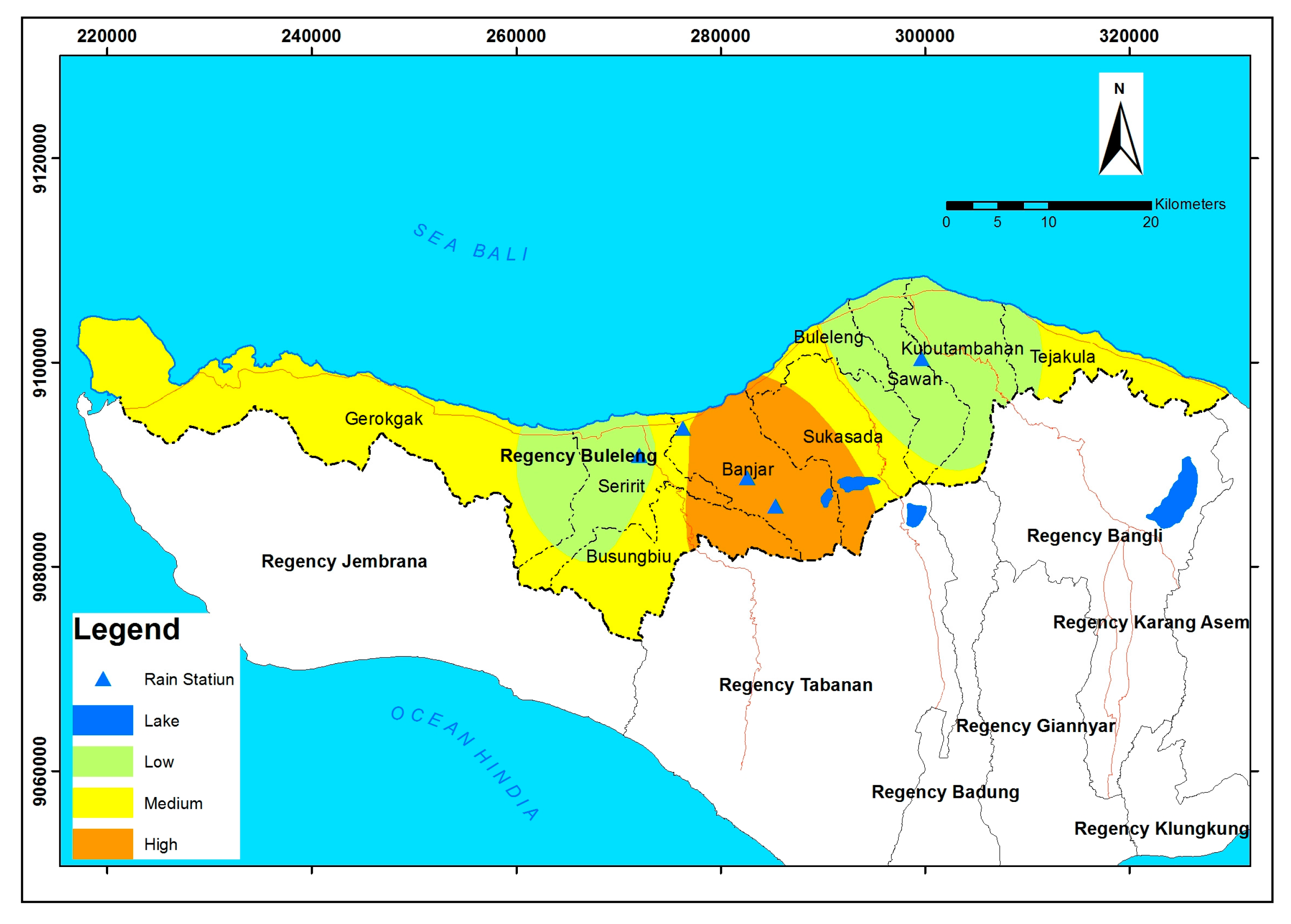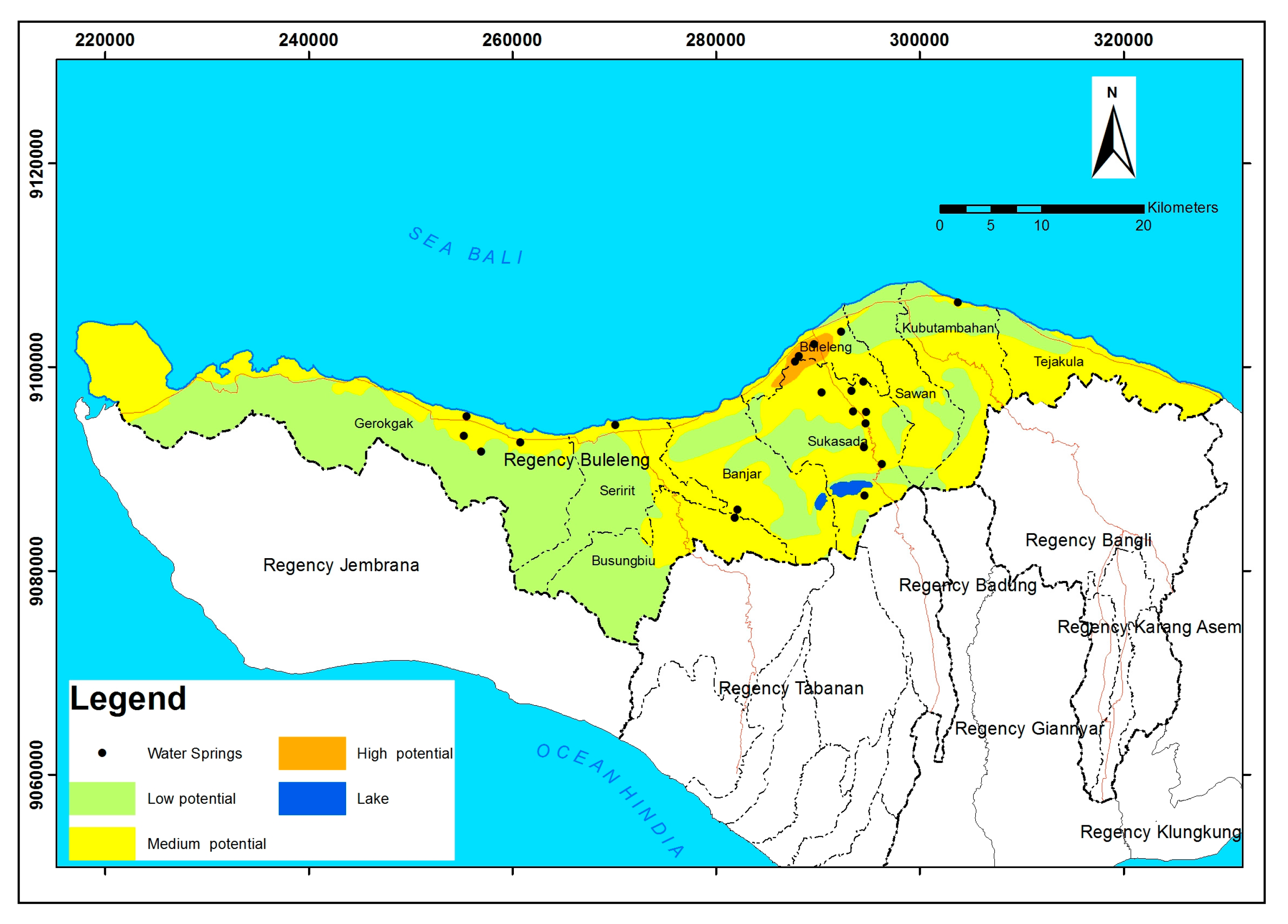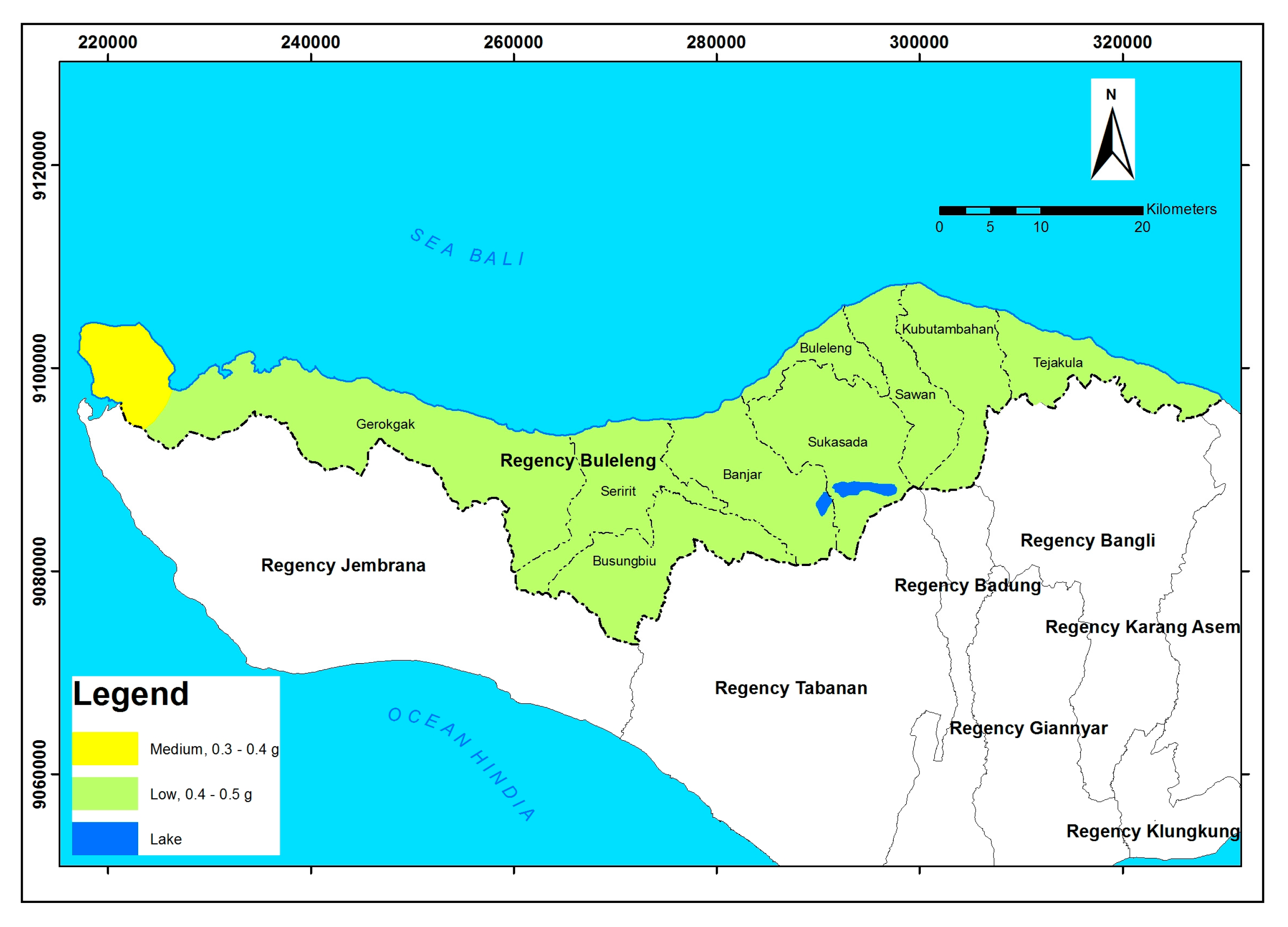1. Introduction
There is a high demand for public information related to spatial planning and environmental protection against landslide hazards, and as such landslide-related hazard assessment has become the main tool in risk management and an integral part of land-use planning in disaster-prone areas [
1,
2]. Zoning of landslide hazards is associated with the environmental conditions involved in homogeneous land sharing. Determination of the level of threat is based on the classes specified by the researchers themselves and their objectives and experiences. Hazard assessments are usually indicated on a map which displays spatial distributions or hazard class zones [
3,
4]. However, the probability of landslide events is still difficult to clarify in most of the hazard maps due to different environmental conditions and the scarcity of previous landslide events or historical events [
4,
5]. As a result, most of the published hazard maps present only spatial information of landslide hazards and do not provide an estimate of when a landslide may occur.
Various methods have been developed and applied to landslide hazard assessments in recent years, ranging from simple to very sophisticated methods, using a large number of landslide parameters [
6]. Hazard assessment can be classified into two approaches, namely, qualitative and quantitative methods. The choice of this method relies heavily on the accuracy of the results and the nature of the problem and must be made depending on the quality and quantity of the data available. Generally, for large areas where the quality and amount of available data is too limited for quantitative analysis, threat assessment with qualitative methods is more appropriate. In contrast, for slopes in close locations an equilibrium boundary strength analysis is performed, which requires a detailed quantitative assessment of hazards.
Assessment and weighting have been performed by Indonesian scientists using semi-quantitative methods or heuristic methods for a depiction of risk maps. This involved overlapping using geographic information (GIS) to create landslide threat maps, and assessment and weighting applied to several parameters based on their relative contribution to landslide hazards. Other studies that have been conducted include comparisons of Soil Stability Index Mapping (SINMAP), and Shallow Slope Stability (SHALSTAB) modeling approaches for slope stability analysis at shallow landslide sites, showing the practical advantages and limitations of the two models with respect to the highly dependent characteristics of local geological conditions [
7].
Bali island is characterized by generally steep rolling hills in the northern part and steep plane morphology in the southern part [
8]. The geological structure of most areas of Bali island is composed of clastic volcanic rocks from the Quaternary age. Rocks in the northern part of Bali island have been strongly deformed, marked by the many geological structures including both faults and folds. The Flores Thrust stretches from the north to the south of Bali Island, while the eastern part consists of the tuffs and volcanic breccias which were formed in the Pleistocene age (dating back from 2.33 ± 0.12 million years to 0.77 ± 0.06 million years ago), and are very easily eroded by rain [
9]. There are various geological conditions and geological structures in each region, which are the dominant controlling factors in the evolution of landforms and geological structures, and these dynamics are reflected by landforms [
10,
11]. In addition, a landslide with a gentler slope occurs with a lower dynamic coefficient of friction values, and in the case of the debris flow, there tends to be an even lower dynamic friction as compared to the case of landslides high slope declination [
12]. The Buyan-Beratan Purba volcanic rock group (Qpbb), consists of tuffs and volcanic lava sediment from Buyan-Beratan and Batur, which are from the upper Quaternary age. The appearance of landscapes and geological conditions is based on the geological map of Bali sheet [
13].
This study, conducted in the Buleleng district, covers an area of 1365.88 km
2 or 24.23% of the Bali province area, with the Sukasada sub-district being the main observation location because this area often experiences landslides. Administratively, the area of the Sukasada sub-district, which measures 366.92 km
2, comprises about 70.45% of the Buleleng district area. This study was conducted in the Buleleng district, which is a district formed in the overflow of the Buyan-Beratan ancient mountainous areas and has a high occurrence of landslides (36.5%) [
14].
The primary purpose of this paper is to present a landslide hazard assessment by comparing the deterministic and semi-quantitative methods around the ancient mountainous area of Tamblingan-Buyan in Buleleng, so that the most relevant methods in the area can be identified and applied under the same location conditions. The semi-quantitative method with overlay operation in GIS is used to analyze the following physical aspects of nature: (1) slope inclination; (2) weathering rocks; (3) geological structure; (4) rainfall; (5) groundwater potential; (6) seismicity; and (7) vegetation. The deterministic method with SINMAP extension analyzes the landslide potential area using soil parameters. In this type of modeling, the area is divided into six classes, whereby each region has a stability index value to determine whether it is in an area with landslide potential or not.
3. Results and Discussion
The main reason for landslides is imprudent land use. The impairments draw attention to those conditions which must be considered in the case of previously unbuilt ground [
20]. The control points were in the form of points where landslides had been recorded. Based on these points, predicted landslide points were generated according to the circumstances in the field where landslides had occurred previously. The conditions of the points predicted to have low soil stability can be seen in
Figure 3 and we can see that the resulting stability index map corresponds to the conditions in the field, namely, that landslides had occurred in the area where it was indicated that they would occur. The conditions of the points which were predicted to have low soil stability can be seen in
Figure 4.
Soil sampling for SINMAP analysis was taken from points in 10 villages. Nine points in the villages were established with the purpose of the control of the land properties of the study area. One village (Pancasari village, with three boreholes) is the main point located in the research location. Soil property testing at 10 sampling points in the Buleleng district can be seen in
Table 2.
3.1. SINMAP Method
The SINMAP method, which is an additional extension of ArcGIS, is used to analyze the assessment of the hazard level for landslides. The study is only carried out in a narrower area, the Buleleng regency, in particular in the Sukasada sub-district, which is an ancient mountainous area. The sampling of soil in the research area used in SINMAP was performed using the cohesion value and the internal friction angle, which determined the range between the lower limit and upper limit, depending on the dominant soil type in the research area. Boreholes for sample controls were also used in other regions around the study area.
The research area in Buleleng District, as seen in
Table 1, had a cohesion value (
c) with the lowest lower threshold of 0.427 kPa and the highest upper threshold of 0.919 kPa. The friction angle value in soil (
φ) with the upper threshold was 42.88°, and the lower threshold was 18.99°. Referring to the soil hydrology classification table based on the soil texture [
3,
21], the hydraulic conductivity value for the sandy clay loam soil type was 0.43 cm/h, and for silty clay it was 0.09 m/h. The transmissivity value obtained for the upper threshold was 0.0215 m
2/h and for the lower threshold it was 0.0027 m
2/h with a soil thickness of 4–5 m.
The parameter values R (for upper threshold R and lower threshold R), were found using the wettest monthly rainfall in each year per rain station, after the wettest month in each year had been determined. Next, the wettest week averages of each year were determined so that the rain data was obtained for the maximum seven-day rainfall. As per the rainfall station in Sawan village, the wettest month was in November 2005, with maximum rainfall (Rmax) of 125 mm and minimum rainfall (Rmin) of 65 mm. Based on the above data and analysis, the soil moisture index (T/R) was obtained using a lower threshold of 0.5184 m and an upper threshold of 23.88 m.
Table 3 and
Figure 4 show a map of the soil movement hazard based on SINMAP modeling. The soil movement hazard level in the Buleleng district was rated at a moderate to high level. The medium hazard level was 9.39%; in an area of 12,831 ha, including total landslide events, there were as many as 13 landslide points with a landslide density of 0.0001 landslide per ha. The high hazard level was 0.19% or 253 ha with landslide events, with as many as five landslide points and a landslide density of 0.0004 landslide per ha.
SINMAP modeling showed the spread of landslide points based on the slope and area (S-A plot) as shown in
Figure 3. The unstable slope stability level generally started to occur on the slope inclination between 20° and 40°, with the area covering almost 1000 m
2. Based on the density of plot points through which we could also find the distribution points of landslide spots; the spread of most landslide points was on a slope inclination between 20° and 25°.
3.2. Assessment Parameters
According to the Regulation of Minister of Public Works Decree No. 22/PRT/M/2007 the weighting of each parameter was recommended in the regulations as follows: 30% slope inclination; 15% rock weathering; 20% geological structure; 15% rainfall; 7% groundwater potential; 3% seismicity, and; 10% vegetation. Based on the literature study, all the assessment components are relevant to the environmental conditions in Indonesia as a tropical country. The use of these seven parameters is very appropriate in this study. Assessment of the weight of landslide threat on each indicator is done through multiplication of the index weight by scoring weight. There were five scoring levels for hazards: (1) very low; (2) low; (3) medium; (4) high; and (5) very high, enabling accurate and detailed results, and this can be compared with the SINMAP method, which also has five levels in the stability index.
Criteria and indicators weight and score each of the parameters in the creative zone based on the height of the area in this research area. Furthermore, the software ArcGIS 10.3 performed the procedure of calculation and determination of the region of the threat of ground motion in the overlay between the map parameter with a map of landslide hazards. The overlay map parameters produce five index values with respect to the hazards of landslides, with the threat level ranging from very low to very high. The scale interval of the hazards of ground motions at each zone area are as shown in
Table 4.
The analysis and assessment of the landslide hazards level are carried out first, and are then overlaid on each parameter map to obtain a hazard map. The slope inclination reached 14.68% in the C zone with the height of <500 m above sea level. Most of the regions were in zone B and C and this condition is shown in
Figure 5. Areas with thick soil had the potential for higher soil or rock movement. The identification of rock weathering was seen from the matrices of the surrounding fresh rock, the greater intensity of the matrix means the rock had been weathered in moderate intensity [
20]. The level of rocks weathering of slope constituent can be seen in
Figure 6.
The fracture was the perpendicular distance between two consecutive fractures along the stretch line. The geological structure of the study area was distinguished by the fracture distance in an area which was divided into very dense, dense, medium, wide, and very wide categories [
21,
22]. The conditions of the geological structure can be seen in
Figure 7.
The rainfall parameter was measured in the annual average. Furthermore, the isohyet method was used to calculate the rainfall intensity based on rainfall station data in the research area. The map of rainfall intensity was based on rainfall data from four observation stations from 1994 to 2016. Rainfall intensity can be seen in
Figure 8.
The groundwater potential in the research area was classified into five types based on the neighborhood units of Bali province. The groundwater potential was high when the rocks were tuffs on vesicular lava or were brick residual volcanic rocks. The medium groundwater potential was found in alluvium soil types. The groundwater potential was low and located in swamp sediment alluvium (coastal plains, a deposition result of tertiary rock). The underground water potential was rare at the top of the volcano in the rocks. The explanation of groundwater conditions can be seen in
Figure 9.
The seismic model review map was reviewed based on the 2010 hazard map of Indonesia earthquakes issued by the Ministry of Public Works using the peak ground acceleration (PGA) in the bedrock (SB) for probability exceeding 2% within 50 years of building service life or corresponding to an earthquake return period of 2475 years [
23]. The review of seismic conditions can be seen in
Figure 10.
Based on the Indonesia Topography Map of Bali Province with a scale of 1:25,000, vegetation coverage classes were categorized into: shrubs, forests, fields, grasslands, plantations, irrigated paddy fields, and rain-fed rice fields. Land usage types such as rice fields or moor and scrub, especially in areas that have steep land, usually experience frequent landslides.
Figure 11 shows the vegetation coverage of the research area.
The overlay between trigger parameters map produced a soil movement hazard map as shown in
Figure 12, as well as a mass movement hazard index value ranging from very low to very high hazard levels, with a mass movement hazard scale interval in each zone as shown in
Table 5. High and very high threats were mostly located in the B (33.46%) and C (19.25%) zones of the total area of the Buleleng district. In the ancient mountainous regions of the Buyan-Tamblingan region in the Sukasada sub-district, the soil movement hazard level was very high because it is located in the C zone and has a high level of rainfall.
4. Conclusions
Deterministic modeling with SINMAP combining geotechnical factors and a slope hydrological model with geomorphological approaches gives an evenly distributed classification of soil movement hazards. At high and very high hazard levels, this model only gives validation equal to 14.29%, whereas the overlay method with trigger parameters of soil movement yields a validation of 71.43%, as shown in
Table 6.
The use of parameters for study is a method that provides far more accurate results than the SINMAP deterministic method. The SINMAP deterministic model is limited to actual landslide modeling because it is based solely on test results and calculations of soil geotechnical parameters and the quality of DEM data used. In other words, the SINMAP deterministic model performs poorly for a wide range of heterogeneous land characteristics.
The results of this study support the use of weighting parameters, with weight percentages as given previously, as the results of the survey are quite extensive. Weighting also allows for modifications according to the characteristics of the study area, beginning with geotechnical observations and investigations. The analytic hierarchy process (AHP) method allows for a high level of modification of the weighting scale for each of the parameters, and this is greatly influenced by the experience of the researcher as well as environmental conditions.
